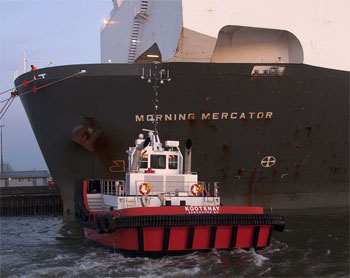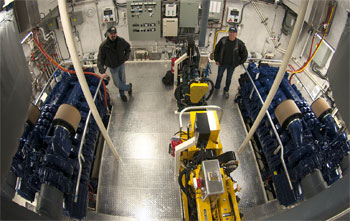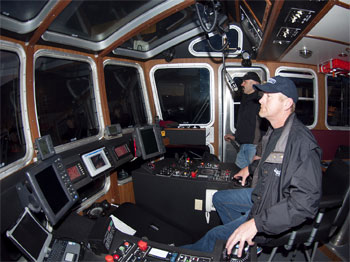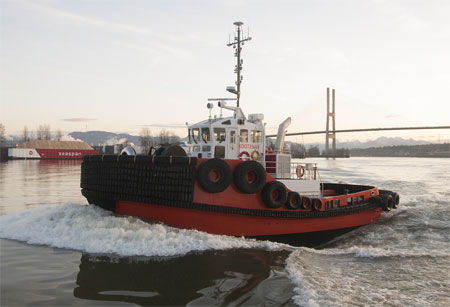“They say that this is the most powerful docking tug for the size,” Capt. Bill McLerie said as I boarded the 64.3-foot 5,000-hp tug Kootenay. There is a danger in using such superlatives, but with this boat it is tempting.
The owner of the new tug, Samson Tug Boats Inc., is a relatively new company offering ship-docking services on the Fraser River, which is part of the Port Metro Vancouver in British Columbia. In 2011, Samson took delivery of the 3,200-hp 58-foot Shuswap and took two conventional tugs under charter. The new boat gives the company a working fleet of four vessels, two ASDs and two conventional tugs.
 |
|
The tug shows what it can do while docking a car carrier at Annacis Island on the Fraser River. The tug was built at ABD Boats and designed by the naval architectural firm of A.G. McIlwain Ltd. |
Shuswap has a 28-foot beam and is propelled by two 1,600-hp MTU engines and z-drives. The 64.3-foot Kootenay has a 32-foot beam and a pair of 2,500-hp mains. Both boats were built to designs by West Vancouver naval architect A.G. McIlwain Ltd. With a lion’s share of recent British Columbia-built tugs as well as docking tugs in New Zealand and Australia, McIlwain is noted for beamy and powerful boats. The extra length and beam give the new boat’s bright orange-red hull a similar 2:1 length-to-beam ratio.
As McLerie turned the z-drive controls to ease the tug off Samson Tug’s office barge, the powerful engines made the boat dance like a top, but the wide beam kept it on a relatively even keel.
 |
Together with Shuswap, Kootenay idled at 650 rpm on the big MTU 16V4000 mains. The crew tracked, via the AIS, the 652-foot car carrier Morning Mercator as it covered the last of the 20 miles up from the sea. With a 28.5-foot draft the ship was making just over 12 knots against about 1 knot of river current.
At 0515 the big high-sided ship emerged from the early March darkness. The ship’s river pilot, Capt. Dave Marjoribanks, called the tugs: “Kootenay, I’ll get you to put your line up aft either on the sunken bitt or on deck. Shuswap, you can start out on the starboard quarter.”
McLerie explained that this was an older ship, built in 1988, so the tonnage limits of the sunken bitts near the waterline won’t be marked in the ship’s side. But with a 60-ton bollard pull Kootenay routinely puts the hawser up to the Panama chock on the ship’s transom. Even then it is important to have clear communication with the pilot regarding power settings of the tug versus the bitt strength, as the deck chock and bollard on many ships will not be strong enough for the tug’s potential. The bollard on this car carrier was rated at only 32 tons.
The river port has tighter turning areas and some piers that are difficult to access. The shorter tugs have an advantage in maneuvering in these tight spaces. At the same time the azimuthing stern drives, along with the double-chine hull, allow the tug to easily hold a ship against the pier even with strong crosscurrents that can come during the Fraser River’s spring freshets. Kootenay’s drives are ZF AT-7111 FP Thrusters.
As McLerie eased the tug up to the transom of the car carrier, deck hand Steve Swanson, a master mariner with experience on Canada’s East Coast and in the Gulf of Mexico, went out onto the tug’s foredeck to catch the heaving line lowered by the ship’s crew. He quickly tied it to the eye spliced into the end of the 450-foot-long, 8-inch-circumference hawser.
 |
|
Deck hand Steve Swanson and Capt. Bill McLerie with the MTU diesels in the cavernous engine room. |
Returning to the wheelhouse, he worked the lever that payed out line from the hawser winch, a Markey DYS-42 model with Render/Recover capacity and a 400,000-pound brake hold and a 22,000-pound line pull. A massive stainless steel staple has been painted black on the backside to prevent glare to the pilothouse. The hydraulic winch draws power from a dedicated John Deere 6068 auxiliary engine with a Parker pump set on the back end. The John Deere also has a 30-kW generator on the front end that serves as an emergency backup. The main generator is a 30-kW Stanford coupled to a Kubota V3300w engine.
Owning partner Gordon Yahn explained that “the systems on the Kootenay were designed to be as close to identical to the Shuswap as possible. We wanted to make the transition for our crews to be seamless when operating the different boats. Switches and system controls are in identical positions on the consoles. Radios, lights, alarms and breaker panels are in the same locations as well.”
When Swanson stepped into the wheelhouse, he was immediately in position with the winch controls mounted on the starboard side of the split console. Having the winch controls on the main console puts the person handling them right next to the captain for ease of command.
As the ship moved up river, McLerie idled aft at 650 rpm to allow the ship to keep the big prop turning and water flowing over the rudder to maintain steerage. At 0535, as the ship came abeam of the car terminal pier, the pilot ordered, “Kootenay, back easy” and McLerie throttled up to 985 rpm to stop the ship.
Minutes later the pilot ordered, “Shuswap, push half. Kootenay, 90 to port, pull half.”
As the big ship swung 180° to face down river, her stern scribed an arc about 50 feet off the bulkhead. The nimble Shuswap, on the pilot’s order, moved from the starboard quarter to take up position on the port quarter. Kootenay was ordered to stand by straight aft. A series of commands followed to move the ship down along the bulkhead to a position correctly aligned for the cargo ramp and for the line boat to take out the four mooring lines.
 |
|
Capt. McLerie at the z-drive controls, while Swanson, a master mariner acting as deck hand, stands by the winch controls. The hawser winch is a Markey DYS-42 model with Render/Recover capacity. |
By 0610 the mooring lines were secure and the tugs were released to head back to their base. This job was almost too easy for the pair of powerful modern boats. But come spring freshet and some deeper draft vessels, there is little doubt that the pilots will be appreciating the power and agility of these two ASD tugs in the Samson fleet.

